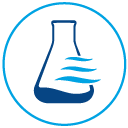
Understanding the Role of PAHs Testing in Marine Environments
It has long been understood that the toxicity of polycyclic aromatic hydrocarbons (PAHs) in our environment has caused health problems for living organisms including humans. The two or more fused rings in PAHs chemical bonds make them very long lasting. And their toxic effects include the tendency to cause mutations in human cells and can lead to cancer. It has only become a more recent concern to study PAHs effects on marine life. Sediments, surface water, plants and animals have been studied to determine what can and needs to be done to mitigate the dramatic rise in levels of these toxic compounds. Although PAHs are naturally occurring their levels have risen dramatically due to human production from burning fossil fuels, incomplete combustion (car exhaust), oil spills and other industrial processes.
1. What is special about marine environments?
The quality of marine water is vitally important to all of the plants and animals living in our seas and oceans. This water quality affects the most basic elements of life in the marine environment such as surface water phytoplankton. These tiny plants and plantlike organisms are highly effective at locking up carbon (CO2) and converting it into oxygen thereby adding absorbed oxygen to marine waters. The more highly oxygenated the water is in the marine environment, the more marine life is able to thrive.
Because oceans cover 70% of the surface of earth, the health of our marine environments is important for a host of reasons including climate, food sources, rainwater, biodiversity, weather, and overall planetary and human health. How we care for our marine environments and help to identify the pollutants that are causing harm to them will be incredibly important for our health and our future.
2. What are the effects of marine pollution on the environment?
The major concern for PAHs effect on marine life is measured by scientists in the bioaccumulation of these toxins in living organisms. However, their presence in surface waters also affects the health of phytoplanktons which, as already mentioned, are essential to carbon locking and oxygen production. This is a concerning and critical issue for aquatic health and could be a contributing factor to the deterioration of marine ecosystems in recent decades.
PAHs are highly lipid soluble which means they are easily incorporated through digestive processes and distributed in fatty tissues throughout aquatic animal populations. As levels have risen in marine environments they have risen in marine fish, shellfish, invertebrates, birds, mammals and anything else that consumes these as food, including humans. PAHs effect on marine life is not just carcinogenic. They can also cause reproductive, behavioral and growth problems in marine species.
A major concern about the toxicity of polycyclic aromatic hydrocarbons has been the fact that it causes cancer in humans. We have known about this carcinogenicity since the early 1900’s when chimney sweeps contracted skin cancers at an alarming rate. For over a century scientists and doctors have been aware that PAHs production from fossil fuels was compromising our health and the health of our land, air and water. However, we have tended to believe that the massive size of the oceans would protect them from our waste production. Unfortunately we are now experiencing the toxic effects of centuries of industrial pollution, explosive population growth, agricultural chemical runoff, deforestation and other influences on marine environments that we once thought would be immune to such effects.
3. What is the role of PAHs testing in marine environments?
It is extremely important to test the levels of PAHs in the surface waters and sediments in our marine environments. This is because some of the PAHs are entering these ecosystems through air distribution or oil spills on the surface of oceans while others are delivered through river pollutants in harbors and settling into the underlying sediment.
Recent studies in China have revealed higher levels of PAHs in aquatic environments in which the origins can be traced back primarily to coal burning and industrial production. Discovering and mitigating the sources of PAHs will be extremely important for improving the overall health of marine environments. For this reason we must continuously test our marine environments and take the appropriate steps to limit the production of these pollutants.
4. Conclusion
Unfortunately we are not able to lower the toxicity of polycyclic aromatic hydrocarbons. But by increasing our awareness of PAHs effect on marine life and marine environments in general we will be able to take the necessary steps to test for these pollutants, identify their sources and reduce their production. Taking care of our marine environments is incredibly important for human health and for the health of our planet.
Torrent Laboratory has all of the most advanced instruments and technology for low level testing of PAHs in soil and water.
We offer 8270 and 8270 SIM testing for PAH (Polynuclear Aromatic Hydrocarbons) in soil and water. The 8270 test method has reporting limits that are generally around 0.5 ppbv, which in most cases is sufficient for soil and water monitoring.
Torrent Lab has built a strong reputation on providing Six Sigma level, highly predictable on time quick turnaround times for testing and analysis. Torrent offers many turnaround time (TAT) options. Our standard TAT is 5 business days.






